Unplugged: TANKS – a beginner’s miniatures wargame
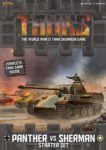 TANKS: Panther vs Sherman Starter Box
TANKS: Panther vs Sherman Starter Box
Designers: Andrew Haught, Chris Townley, Phil Yates
Publisher: Gale Force Nine, LLC
Players: 2
Ages: 8ish
Time: 30 minutes
TANKS is a new, lightweight system of miniatures from Gale Force Nine, focusing on (surprise) the tank battles of World War II. The idea is to have a fast-playing miniatures wargame to serve as an introduction to the hobby. This is the first wargame by Gale Force Nine, who produce a prodigious amount of pre-painted battle terrain, presumably usable in TANKS games as well as the more complex Flames of War game owned by GF9’s parent company, Battlefront Miniatures.
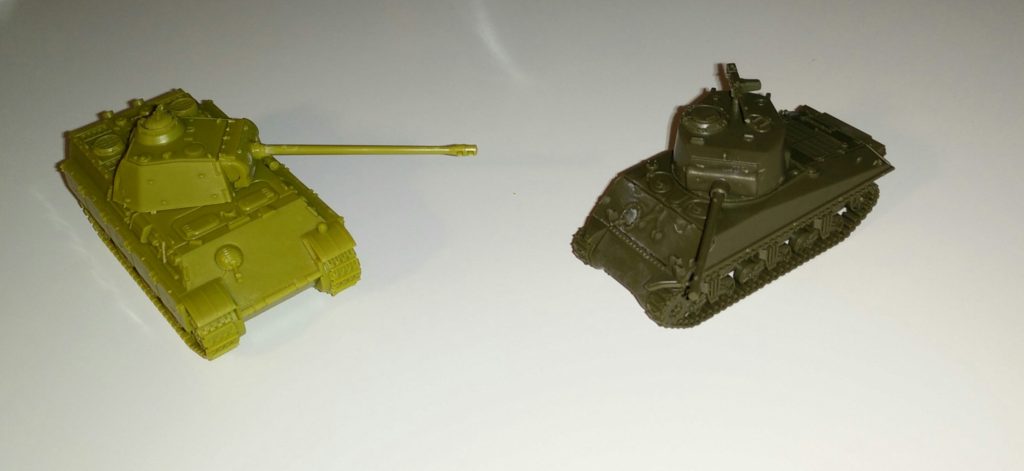
Two of my tanks, a Panther and a Sherman.
The game does boil down tank battles to make for a fast game. All the tanks move using the same cardboard “arrow” to measure movement, with quickest tanks moving last. Then all the tanks shoot, with the quickest tanks shooting first. Attacking tanks roll their dice (usually quite a few), scoring hits with a 4 or 5 and a critical hit on a 6. (If the tank did not move this round they can reroll the entire set of the dice one time if they wish.) The defending tank rolls their defence (usually only a few), blocking any type of hits on a 4 or 5 (chosen by the attacker.) A 6 rolled in defense also blocks a hit or critical hit, but the hit is chosen by the defender. Bonus defensive dice are added to the roll if the defending tank has moved earlier this turn, the attacking tank has moved earlier, and if it is under cover (partially in woods, etc..) Close range shots or ones hitting a tank’s side will subtract defensive dice.
Any leftover basic hits are marked off on a tank card. Each critical hit requires a draw from the critical hit deck. Each card in the deck will note some damage (usually one or two) and will often also bestow some negative modifier on the target. This could include “locking up” one’s turret (so that attacks can only be made towards the forward arc), damaging the tracks (so the tank can no longer move), or simply extra damage. Some ongoing effects are permanent, one of which can be “repaired” with a 50/50 chance at the end of each round.
That’s the entirety of the basic rules. The rulebook has plenty of pictures and examples for most of the situations. My one complaint lies with the rules about line of sight and terrain effects. The layout for those rule examples are very pretty, but because the terrain in the photo is overlaid onto a fancy terrain background, it is difficult to establish just where the terrain ends and the basic terrain begins. While this muddies the rule examples a bit, it shouldn’t be a problem when playing the game. The included cardboard terrain tiles will clearly have an edge when placed onto the playing area.
The game becomes (slightly) more complex through the use of modifier cards. Most TANK games start with a point limit that players can spend on adding tanks to their platoon as well as tank upgrade and crew cards. Upgrade and crew cards played on a tank makes it more effective. (Since they are only revealed when they are first used in a scenario, they can often come as a nice surprise to one’s opponent.) Each type of tank has a crew limit, and no two crew can have the same role (gunner, driver, loader, commander.) In the same way, each tank can only have one of each type of upgrade (ammo, etc…)
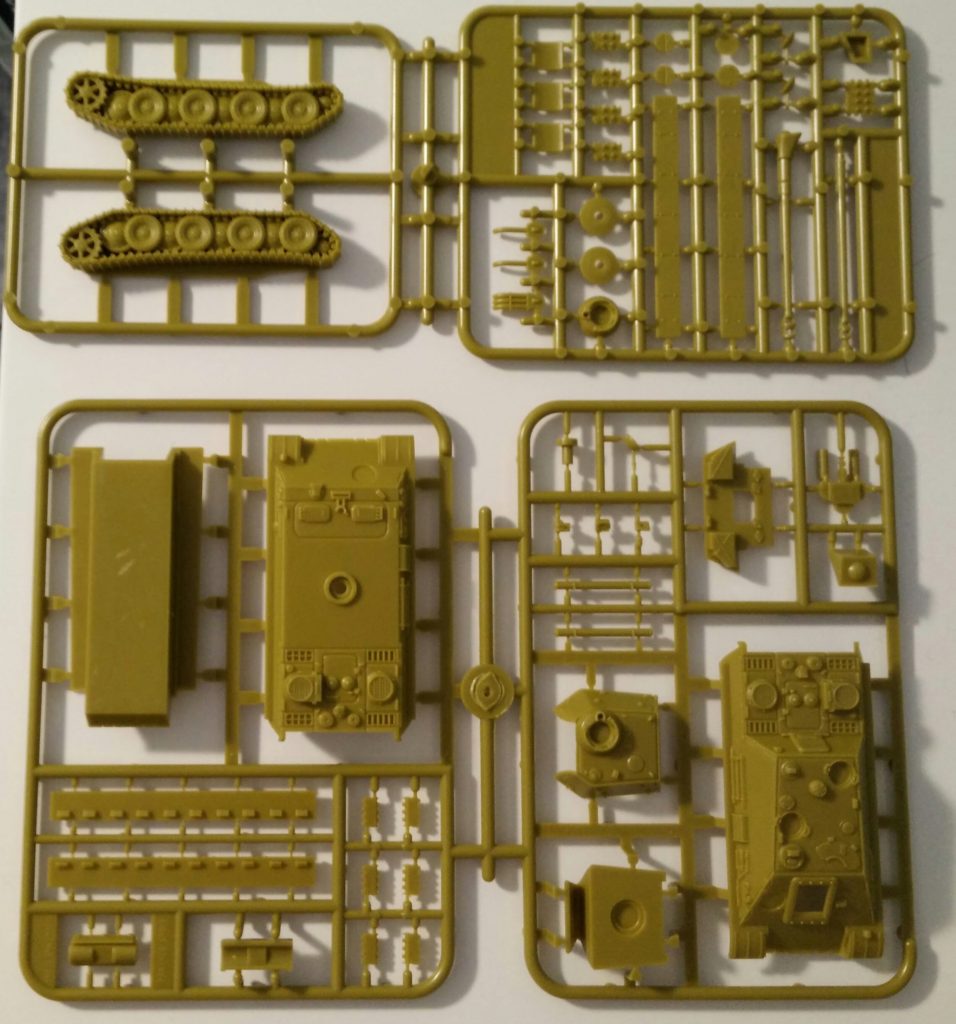
My Pather… before construction.
Game bits and pieces
Unlike more euro-friendly wargames, the tanks in TANKS come disassembled. The starter set comes with three sprues. Each sprue has all the pieces required to build an entire tank. There is a German Panther and two Sherman tanks. (The two Sherman tanks even have a spare turret to make the main gun into either a 76mm or 75mm turret.)
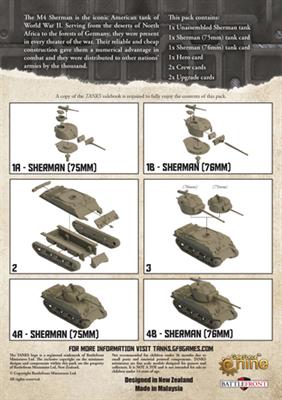
The assembly instructions.
The rulebook has two pages with fairly clear assembly instructions. I am not a model builder, but I managed to muddle through. The illustrations are only from one angle, so there were a few times I wasn’t sure what I was doing, but almost every time the “right” orientation seemed to fit so much better than any other option so I knew I was on the right track. I estimate it took me between 1 to 2 hours to put together the Panther and one Sherman. While the gluing part was putzy, cutting the pieces off the sprue went quickly with a sharp pair of clippers (I wasn’t too uptight about every little bit.) The finished product looked decent.
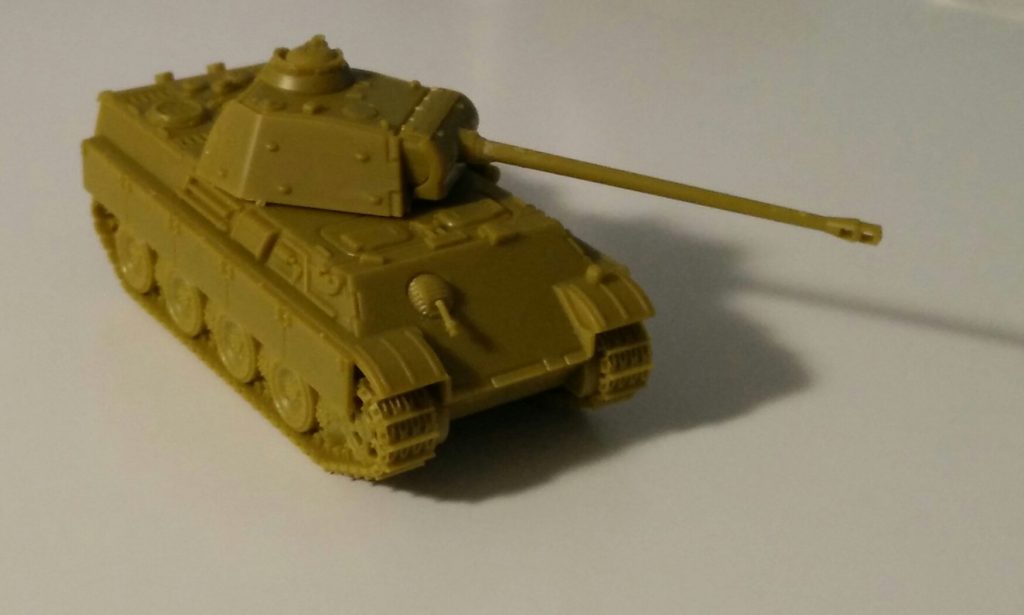
My completed Panther.
I have to admit that a tank self-built out of parts is going to look more impressive than a tank simply extruded commercially. The tiny bits here and there (the cupola, the machine gun up top, etc…) are going to stand out compared to a single-piece model. I worry a little bit about pieces being broken, but the turrets at least do come off (thus they rotate) and can be stored separately from the tank bodies.
In addition to the three tanks, the Starter Set also contains the rules, a pile of cardboard tokens (including a few large bits of terrain that can be placed onto the play area), the critical hit deck, and a healthy mix of generic and named tank upgrades and crew. The set MSRP is $25. Additional expansions (typically one new tank, and a few upgrade cards) run $10 each.
Rules Set
The rules live up to their claim. They are simple enough to play quickly, keeping a feeling of urgency and intensity. The foundation of a simple, generic set of rules is then built up through the use of unit and crew upgrades. The complexity is only slightly increased by the particular upgrades used in a scenario, but their presence makes each scenario a unique experience. The basic rules would be hard pressed to set up something that felt like a historical scenario, but the use of crew cards (including special, historical “hero” cards) makes a historical practical. The “everybody moves” followed by “everybody fires” phases feel a bit unnatural, but I’m willing to sacrifice that for speedier play. The game does not try to simulate grand battles, rather small engagements of tank platoons, which helps to keep gameplay short.
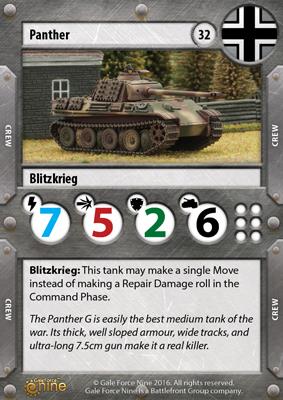
A tank card, note it has 6 hit points and four crew slots.
Verdict:
My final thoughts on the game are mixed. The main problem is that I am not the target audience of the game. I like the rules, I put them somewhere between Memoir ‘44 (a sort of eurogame-wargame hybrid) and the Conflict of Heroes line (a great “simplified” wargame with more complex rules that are somewhat more wieldy through creative use of labels on the cardboard units.)
My primary stumbling block is simply the format. I’m not a huge fan of gluing the little tanks together, I’d rather be doing something else. (At least they come packaged in the correct color plastic, so no painting is required.) If the game were based around premade (probably not as nice looking) tanks or even (horrors) cardboard cutouts, it would be much more likely to make it to the table. Presumably it would also be cheaper than $10 per tank (in the expansions.) As things stand, now that I’ve built my tanks, I expect to occasionally mess around with the game with my young boys from time to time, but I don’t expect to add to my army.
The game does a great job at what it sets out to do, provide a very newbie-friendly way to get into the miniatures wargame hobby. It provides a bit of the construction of plastic models (with optional painting), the idea of building out a set army (through expansions), and has a quick playing set of rules so that multiple scenarios can be played in an evening. If that’s something you’re looking for, or even just want to try out, the starter set would be an excellent place to begin.
(review copy provided by publisher)

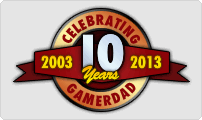



Discussion Area - Leave a Comment